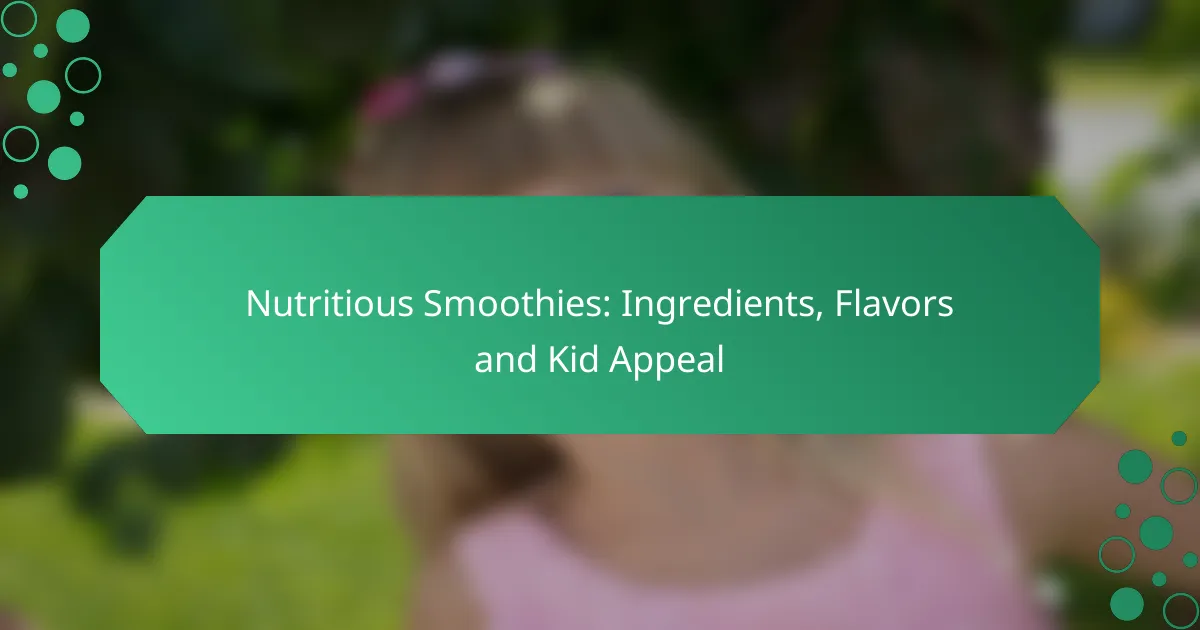Nutritious Smoothies: Ingredients, Flavors and Kid Appeal
Nutritious smoothies can be a delightful way to introduce kids to healthy ingredients while catering to their taste preferences. By blending a variety of fruits, vegetables, and proteins, you can create vibrant and delicious drinks that appeal to young palates. Engaging children in the preparation process and incorporating familiar flavors like chocolate and strawberry can make these smoothies even more enticing.

What Are the Best Nutritious Smoothie Ingredients for Kids?
The best nutritious smoothie ingredients for kids include a variety of fruits, vegetables, and proteins that promote health and appeal to young taste buds. Combining these ingredients can create delicious and nutrient-rich smoothies that kids will enjoy.
Fruits like bananas and berries
Fruits such as bananas and berries are excellent choices for smoothies due to their natural sweetness and rich nutrient profiles. Bananas provide potassium and fiber, while berries are packed with antioxidants and vitamins.
Using frozen berries can enhance the texture of smoothies and eliminate the need for ice, making the drink thicker and creamier. Aim for a mix of fruits to keep flavors interesting and appealing to children.
Leafy greens such as spinach
Leafy greens like spinach are a fantastic way to sneak in essential vitamins and minerals without altering the taste significantly. Spinach is high in iron and vitamins A and C, making it a nutritious addition to any smoothie.
To make greens more palatable, blend them with sweeter fruits. A good rule of thumb is to use one cup of greens for every two cups of fruit to maintain a balanced flavor.
Nut butters for protein
Nut butters, such as almond or peanut butter, add protein and healthy fats to smoothies, helping to keep kids full and satisfied. They also contribute a creamy texture that enhances the overall mouthfeel of the drink.
When using nut butters, start with one to two tablespoons per smoothie to avoid overpowering the flavor. This amount provides a good balance of nutrition without overwhelming the other ingredients.
Yogurt for probiotics
Yogurt is an excellent source of probiotics, which support digestive health. It also adds creaminess and a tangy flavor that can complement fruit and greens in a smoothie.
Choose plain, unsweetened yogurt to avoid added sugars, and consider using Greek yogurt for a thicker consistency and higher protein content. A half-cup serving is typically sufficient for a single smoothie.
Oats for fiber
Oats are a great addition to smoothies, providing fiber that aids in digestion and helps maintain energy levels. They can also make smoothies more filling, which is beneficial for growing kids.
Use rolled oats or quick oats, adding about a quarter to a half cup per smoothie. This will enhance the nutritional value without significantly altering the flavor or texture of the drink.

How Can You Make Smoothies Kid-Friendly?
Making smoothies kid-friendly involves using appealing colors, flavors, and textures that attract children’s attention. Engaging kids in the preparation process can also enhance their interest and willingness to try new ingredients.
Use fun colors and textures
Bright colors can make smoothies more enticing for kids. Consider using fruits like strawberries, mangoes, and spinach to create vibrant blends that appeal visually.
Textures also play a crucial role; adding ingredients like yogurt or oats can create a creamy consistency, while seeds or granola can add crunch. Experimenting with different combinations can keep smoothies exciting.
Incorporate favorite flavors
Identify your child’s favorite flavors and incorporate them into smoothies. Common favorites include chocolate, vanilla, and various fruits like bananas or berries.
Mixing in a small amount of honey or maple syrup can enhance sweetness without relying on processed sugars. Aim for a balance of flavors to ensure the smoothie is both nutritious and delicious.
Involve kids in the preparation
Letting kids help in the smoothie-making process can increase their interest in trying new ingredients. Allow them to choose fruits or toppings and assist in measuring and blending.
Consider setting up a smoothie bar with various ingredients, so they can customize their own drinks. This hands-on approach fosters creativity and encourages healthier eating habits.

What Are Popular Smoothie Flavors for Children?
Popular smoothie flavors for children often include sweet and familiar tastes that appeal to their preferences. Flavors like chocolate, strawberry, and peanut butter are favorites that can be easily combined with nutritious ingredients to create delicious and healthy drinks.
Chocolate banana smoothie
The chocolate banana smoothie is a beloved choice among kids, combining the rich taste of chocolate with the natural sweetness of bananas. To make this smoothie, blend ripe bananas with cocoa powder, yogurt, and a splash of milk or a dairy-free alternative.
This smoothie not only satisfies a sweet tooth but also provides essential nutrients like potassium and calcium. For added nutrition, consider incorporating spinach or protein powder without altering the flavor significantly.
Strawberry mango smoothie
The strawberry mango smoothie is a vibrant and fruity option that children enjoy. This smoothie typically features fresh or frozen strawberries and mangoes blended with yogurt or juice, creating a refreshing drink that’s high in vitamins.
To enhance the flavor, you can add a bit of honey or a squeeze of lime juice. This smoothie is a great way to introduce kids to tropical flavors while providing antioxidants and fiber.
Peanut butter and jelly smoothie
The peanut butter and jelly smoothie mimics the classic sandwich, making it a hit with children. Blend peanut butter with frozen berries, a banana, and milk or a dairy substitute for a creamy, satisfying drink.
This smoothie is rich in protein and healthy fats, making it a filling option for breakfast or a snack. To keep it balanced, use whole grain bread for a side or serve with a handful of nuts for added crunch.

How Do You Balance Nutrition and Taste in Smoothies?
Balancing nutrition and taste in smoothies involves selecting ingredients that provide health benefits while also appealing to the palate. Focus on combining flavors and textures that enhance the overall experience without sacrificing nutritional value.
Mix sweet and savory ingredients
Combining sweet and savory ingredients can create a well-rounded flavor profile in smoothies. For example, adding a pinch of sea salt or a scoop of nut butter can enhance the sweetness of fruits like bananas or strawberries. This balance not only makes the smoothie more enjoyable but also adds depth to the nutritional content.
Consider using ingredients like spinach or kale, which have a mild flavor and can be paired with sweeter fruits. This combination allows you to sneak in extra vitamins and minerals without overwhelming the taste buds. Experiment with ratios to find the perfect mix that suits your family’s preferences.
Use natural sweeteners like honey
Natural sweeteners, such as honey or maple syrup, can enhance the sweetness of smoothies without the drawbacks of refined sugars. These alternatives often come with additional nutrients and antioxidants, making them a healthier choice. Aim for about one to two tablespoons per serving to achieve the desired sweetness without overdoing it.
When using honey, consider its flavor profile; lighter varieties are milder and pair well with fruits, while darker honeys can add a richer taste. Always opt for raw or organic options when possible to maximize health benefits. Avoid using artificial sweeteners, as they can detract from the natural flavors and nutritional value of your smoothie.

What Are the Benefits of Smoothies for Kids?
Smoothies offer numerous benefits for kids, making them a nutritious addition to their diet. They can help increase fruit and vegetable consumption, support hydration, and foster healthy eating habits from a young age.
Boosts fruit and vegetable intake
Incorporating smoothies into a child’s diet is an effective way to enhance their intake of fruits and vegetables. A well-crafted smoothie can contain multiple servings of produce, which is crucial for meeting dietary recommendations. For example, blending spinach, bananas, and berries can create a delicious drink that kids enjoy while providing essential vitamins and minerals.
To maximize the nutritional value, aim for a balance of colors and types of fruits and vegetables. Dark leafy greens, vibrant berries, and citrus fruits can all be included to ensure a diverse nutrient profile.
Supports hydration
Smoothies can significantly contribute to a child’s daily hydration needs. Many smoothie ingredients, such as fruits and vegetables, have high water content, making them a refreshing option. For instance, watermelon and cucumber smoothies not only taste great but also help keep kids hydrated, especially during hot weather or after physical activity.
Encourage kids to drink smoothies as a part of their daily routine, particularly after school or sports. This can help them stay hydrated without relying solely on sugary drinks.
Encourages healthy eating habits
Regularly consuming smoothies can help instill healthy eating habits in children. By involving kids in the smoothie-making process, they can learn about nutrition and develop a preference for wholesome ingredients. Allowing them to choose their favorite fruits and vegetables can make them more excited about eating healthy.
Consider creating a smoothie recipe book with various combinations to inspire creativity and experimentation. This not only makes healthy eating fun but also empowers kids to make better food choices as they grow older.





